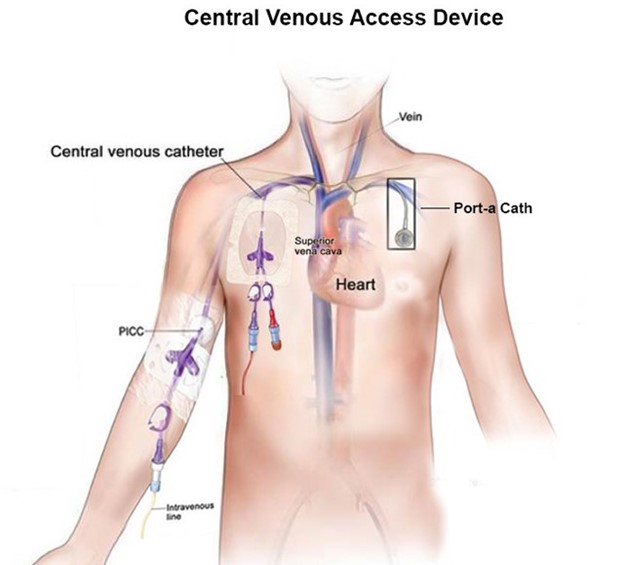A nurse is assisting with preparing a client who is to have a central venous catheter inserted for the administration of total parenteral nutrition (TPN). Which of the following actions should the nurse take?
Verify the amount of TPN solution the client is receiving every 4 hr.
Prepare the client for a chest x-ray to verify catheter placement.
Use clean technique when changing the catheter dressing.
Place the client in Sims' position for catheter insertion.
The Correct Answer is B
When a central venous catheter (CVC) is inserted, it is essential to confirm proper catheter placement to ensure safe and effective administration of TPN and other medications. A chest x-ray is the gold standard method to verify the correct positioning of the CVC tip. It helps determine if the catheter is appropriately positioned in the superior vena cava or another desired location, which minimizes the risk of complications such as pneumothorax or improper medication delivery.

The other options listed are not appropriate actions for the nurse to take in this situation:
- Verifying the amount of TPN solution the client is receiving every 4 hours is a task related to ongoing monitoring of TPN administration, but it is not directly related to the preparation of the client for CVC insertion.
- Using clean technique when changing the catheter dressing is not appropriate for CVC insertion. Sterile technique is required during the insertion of a CVC to minimize the risk of infection.
- Placing the client in Sims' position is not the appropriate position for CVC insertion. The client is typically placed in a supine or Trendelenburg position during the procedure to facilitate access to the central venous system.
Nursing Test Bank
Naxlex Comprehensive Predictor Exams
Related Questions
Correct Answer is B
Explanation
Prednisone can cause blood glucose levels to increase.
The nurse should explain to the client that the reason for checking his blood glucose level is because prednisone, a medication he is receiving, can cause an increase in blood glucose levels. Prednisone is a corticosteroid medication that is commonly used in the treatment of various conditions, including COPD. It has the potential to raise blood glucose levels by promoting gluconeogenesis (the production of glucose from non-carbohydrate sources) and decreasing insulin sensitivity. Monitoring blood glucose levels is important to assess and manage any potential hyperglycaemia or changes in the client's blood sugar levels while on prednisone.
Older adults are not at increased risk for developing type 1 diabetes mellitus in (option A) is incorrect. Type 1 diabetes is an autoimmune condition that typically occurs in childhood or adolescence, and it is characterized by the destruction of insulin-producing cells in the pancreas.
Albuterol treatments, which are used to relieve bronchospasms in clients with COPD, are not known to cause blood glucose levels to decrease in (option C) is incorrect. Albuterol is a beta-2 adrenergic agonist that primarily acts on the respiratory system and does not have a direct effect on blood glucose levels.
Having COPD does not directly cause blood glucose levels to fluctuate in (option D) is incorrect. While there can be various factors that may indirectly affect blood glucose levels in individuals with COPD (e.g., medications, stress, comorbidities), the primary reason for monitoring blood glucose in this case is the use of prednisone.
In summary, the nurse should explain to the client that the blood glucose levels are being checked because prednisone, a medication he is taking for his COPD, can cause an increase in blood glucose levels. This allows for appropriate monitoring and management of any potential hyperglycemia associated with the use of prednisone.
Correct Answer is ["C"]
Explanation
A. Create an opening on the skin barrier that is 1.27 cm (0.5 in) larger than the client's stoma.The opening on the skin barrier should be cut to fit closely around the stoma, approximately 0.3-0.6 cm (1/8 to 1/4 inch) larger than the stoma size. A larger opening (like 0.5 inches) could expose too much surrounding skin, increasing the risk of skin irritation from contact with the stoma's effluent.
B. Use a moisturizing soap to clean the skin around the client's stoma.Moisturizing soaps should be avoided because they can leave a residue on the skin, which may interfere with the adhesion of the ostomy appliance. The skin around the stoma should be cleaned with mild soap and water, or water alone, and then dried thoroughly before applying the new appliance.
C. Empty the client's ostomy pouch before removing the skin barrier.Emptying the ostomy pouch before removing the skin barrier is a practical step to reduce spillage of stool during the appliance change, making the process cleaner and easier to manage. It also minimizes the risk of contamination of the surrounding area or wound.
D. Change the client's ostomy appliance 1 hour after breakfast.Ostomy appliances are best changed when the bowel is least active, which is usually before a meal or several hours after eating. Changing the appliance shortly after a meal, such as 1 hour after breakfast, may result in more stoma output, making it harder to manage the appliance change.

Whether you are a student looking to ace your exams or a practicing nurse seeking to enhance your expertise , our nursing education contents will empower you with the confidence and competence to make a difference in the lives of patients and become a respected leader in the healthcare field.
Visit Naxlex, invest in your future and unlock endless possibilities with our unparalleled nursing education contents today
Report Wrong Answer on the Current Question
Do you disagree with the answer? If yes, what is your expected answer? Explain.
Kindly be descriptive with the issue you are facing.
